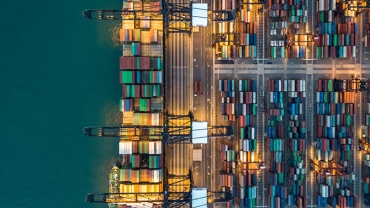
The COVID-19 pandemic has disrupted supply chains, which has damaged in turn global manufacturing. This has forced governments and businesses globally to reflect on the long-term viability of their supply chains. Fortunately for GCC countries the reassessment has more or less coincided with the recent scaling up of ambitious and wide-ranging national development plans. Rather than having to make substantial changes once the developments are already well underway, GCC governments can incorporate a sustainable and resilient supply chain strategy virtually from the outset.
In recent decades, manufacturers have invested heavily in more globalized, specialized, and lean supply chains to reduce costs and to capture efficiencies. Certain countries have provided the majority of the components, supplies, raw or processed materials for many global industrial operations. China, the U.S. and Japan respectively were responsible in 2018 for approximately 29%, 17%, and 7% of global manufacturing output.
However, the COVID-19 pandemic has taught the industrial world a harsh lesson on the fragility of global supply chains. It has experienced a large-scale shutdown of factories, a shortage of supply, and a reduction in logistics capacity. Output has declined substantially, with China’s purchasing managers’ index dropping to a record-low of 35.7 in February 2020.
As a result, governments and businesses are reflecting on their manufacturing and industrial strategies. GCC governments should start this process now as their economies rely heavily on imports of manufactured goods. The proportion of manufacturing output to total national output has been 5.8% in Saudi Arabia and 2.6% in the UAE, compared to around 27% in China and 19% in Japan.
A reconsideration of supply chains should occur in the GCC in the context of national development plans that seek to transform the manufacturing sector, with diversification, localization, and sustainable growth. The UAE’s national development plan, for example, is focused on developing pharmaceuticals, machinery and equipment, food and beverage, and aerospace industries. GCC governments can learn the relevant lessons from what is happening globally, and integrate the goal of agile, efficient, and resilient supply chains.
To make their supply chains more resilient, governments should consider a series of actions.
- 1. Establish domestic supply chains
- 2. Set the right balance
- 3. Promote innovative technologies
- 4. Establish a policy framework
- 5. Accelerate investment
- 6. Run rigorous stress tests
1. Establish domestic supply chains
First, governments should establish domestic supply chains for vital goods. Throughout the pandemic, many countries faced supply chain problems related to food and medical supplies. They were forced to find alternatives to imports by establishing their own factories or converting production lines. By increased localization of selected food and medical supply chains, GCC governments would ensure their resilience to shocks, and generate other socio-economic benefits.
2. Set the right balance
Second, they should set the right balance between localization, regionalization, and globalization. They need to secure strategic autonomy by eliminating excessive dependence on international supply chains. Simultaneously, they should build a carefully considered network of international suppliers to reduce supply-side risk and take advantage of the efficiencies of globalization.
3. Promote innovative technologies
Third, governments should promote innovative technologies such as Blockchain to instill monitoring mechanisms for cross-border trade, manage supply-side concentration risk, and increase transparency. As GCC countries scale up their manufacturing activities, they should clearly set out their national supply-side risk tolerance level with defined guidelines on product origin and desired exposure to different global manufacturing hubs.
4. Establish a policy framework
Fourth, they should establish a policy framework which encourages domestic production and sourcing of supplies. This would involve providing the right environment and incentives to attract investors and suppliers to the region and redirect GCC manufacturers towards domestic and regional suppliers.
5. Accelerate investment
Fifth, governments should accelerate investment in digital infrastructure and technologies, and promote their adoption by domestic manufacturers. GCC manufacturers need to catch up with “industry 4.0,” the intelligent, digital automation that is reshaping manufacturing. Governments should coax manufacturers to deploy cyber-physical-network technologies and advanced data analytics which have already become standard supply chain management tools in advanced economies. To become relevant and merely competitive on a national or regional scale, GCC manufacturers will need to master these technologies. GCC governments will be well-advised to extend equivalent support to their manufacturing champions to that which advanced economies provide to their own.
6. Run rigorous stress tests
Sixth, an appropriate government body should run rigorous stress tests to analyze the response of manufacturers, particularly in critical industries, to various sorts of disruption. This simulation would help regulators and industry leaders to gauge the resilience of supply chains and take the necessary action to strengthen them.
The COVID-19 pandemic offers a unique opportunity for the GCC region to build its manufacturing industry on a secure foundation, and thus help to realize its broader goals of increasing domestic production and economic diversification.
This article originally appeared in MEED, July 2020.
About the authors
Per-Ola Karlsson is a partner, and Maha Raad is a principal with Strategy& Middle East, part of the PwC network.
Contact us

















Menu